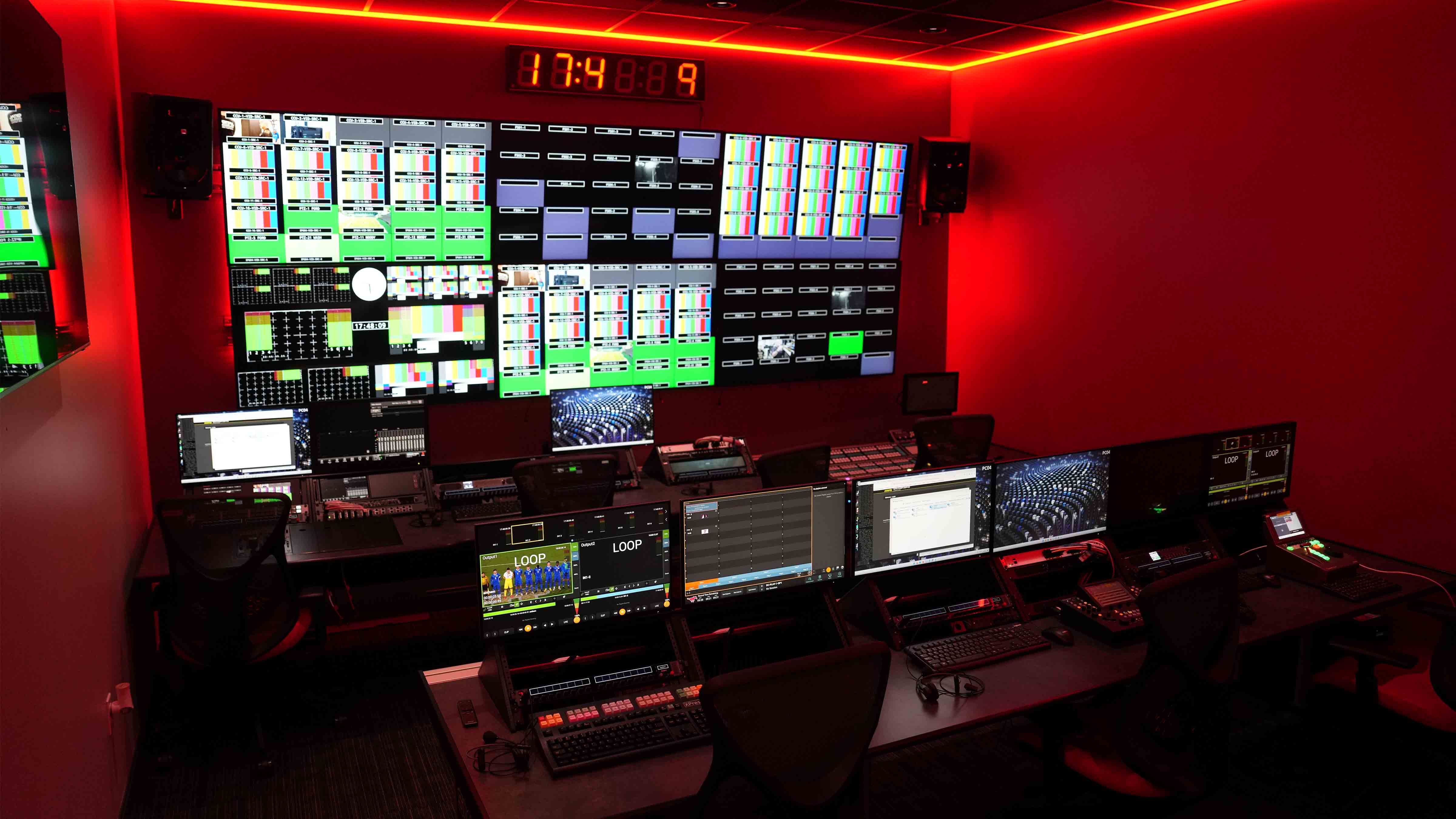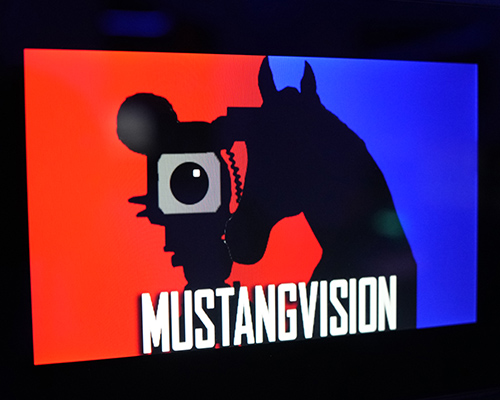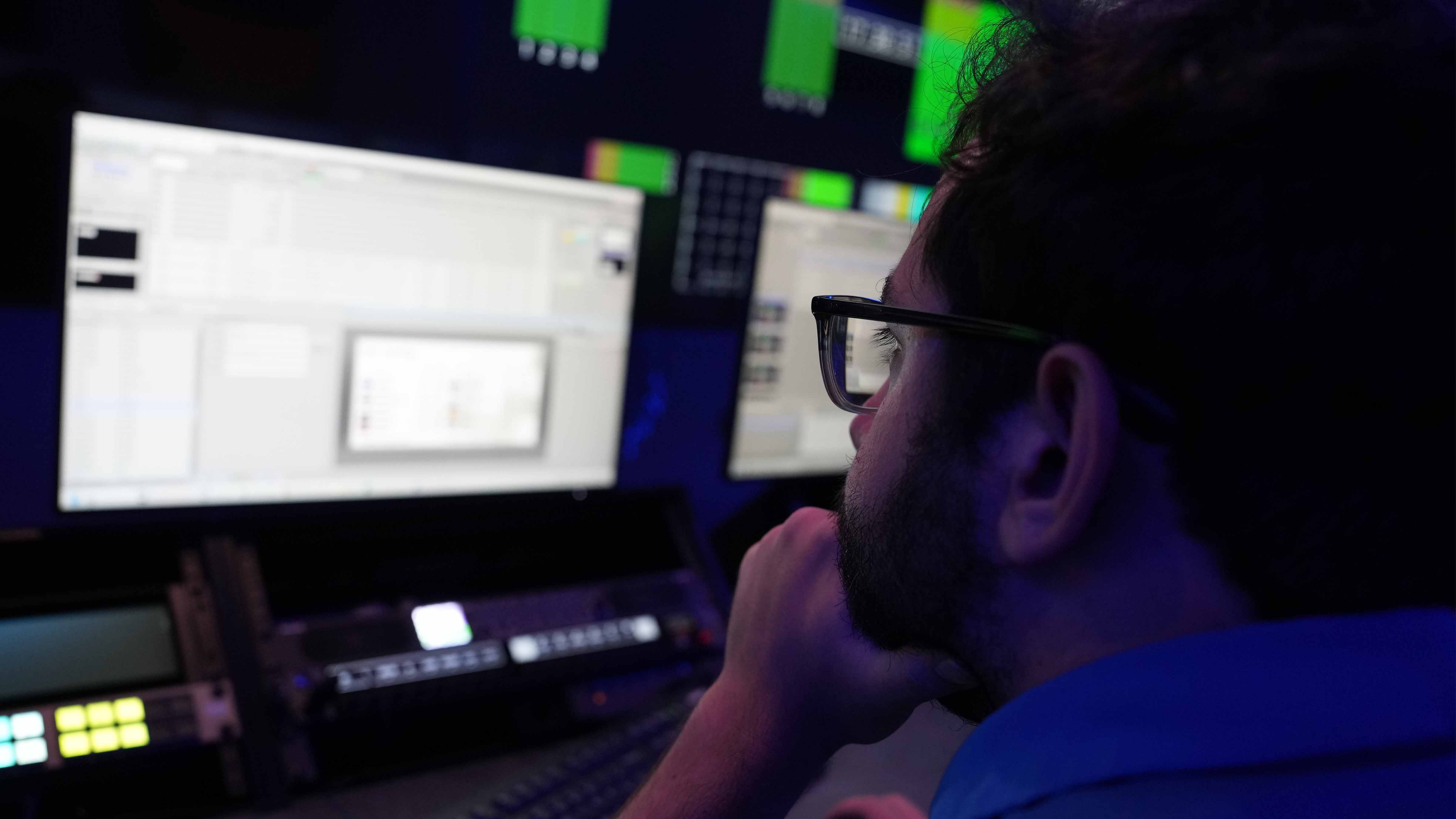MustangVision Struts Into ACC
SMU's new IP-based production facility connects multiple venues across campus.


On Aug. 15, Southern Methodist University (SMU), a private university in University Park, TX, began producing its first soccer game for TV, in-venue, and online coverage from its new IP-based video production facility. Housed in a completely renovated space at the SMU Indoor Performance Center's Armstrong Fieldhouse, the 67,000-square-foot facility is centrally located on the school’s 234-acre campus.
The retrofit, which coincides with SMU's move to the Atlantic Coast Conference (ACC), involved taking the multi-level space down to a shell and rebuilding from the ground up. Now, it stands as one of the most technically advanced production facilities among the ACC’s 18 schools and maybe all of college sports. With its multi-layered sophisticated distributed architecture, any source can be routed at any destination on campus, enabling content to be produced and distributed faster and more efficiently.
Big Brand Builder
The new SMPTE ST 2110 broadcast production facility now serves as the epicenter for SMU's coverage of ACC sporting events, offering enhanced capabilities (and faster turnaround times) for live broadcasts, studio shows, videoboards, and digital content creation. While other colleges and universities have some type of hybrid IP/SDI infrastructure, there are only a handful that are fully ST 2110.
Providing a modern example of leveraging the flexibility and robustness of a distributed IP infrastructure to connect remotely located venues on campus, the first phase of the massive project involved connecting the Washburne Soccer and Track Stadium, Moody Coliseum basketball arena, and Ford Stadium football stadium to the new production center—all supporting the SMU Athletics MustangVision sports content production department. A second phase of the project, to be completed by September, will connect more sources and the school’s aquatics, lacrosse, and tennis facilities on campus.
Since 2020, SMU had produced content on ESPN+ as part of the American Athletic Conference TV deal. It has been sharing content with all ESPN schools since then, including schools in other conferences. In 2021, SMU rebuilt an existing control room to meet the needs of ESPN linear broadcast requirements.
“The video aspect of it this project is a big reach and a big brand builder [for SMU],” said Spencer Jones, SMU assistant athletic director and director of the MustangVision team. “Our goal is to help grow the ACC Network. I can't come in there and just piddle around and be average. We want to be good partners with the ACC and ESPN. We wanted to have an environment that when they walk in here to help us produce games, they will feel comfortable with the technology and systems in place.”
A daily selection of features, industry news, and analysis for AV/IT professionals. Sign up below.
Time Is of the Essence
There are many aspects to marvel at, but the most impressive might be that the project, led by Jones and his MustangVision team, was completed in a mere eight months. Initial discussions began in December 2023 with Anthony James Partners (AJP), a broadcast systems designer and tech consultant that has worked with a variety of colleges to build out their media production systems. The actual build started in February.
“Everybody went in with the mentality, ‘This is an impossible task’,” said Mike Martin, VP of technology at AJP. “But soon we had our collective noses to the grindstone and all parties involved committed to getting it done. With everyone focused on the same goal, we knew that anything was possible.”

To get the job done, Jones brought in several vendors, working simultaneously, to help. Throughout the duration of the build, the various entities formed a collaborative working partnership. It started with AJP and then involved the university, SMU Athletics, and the Office of Information Technology (OIT) in the planning and design stages. This was followed by close coordination with GSBS Architects, which designed many of the production spaces; Clark Construction, which was responsible for building out the facility; Digital Resources, which installed the fiber connections, room lighting, and venue technical drawings; and ZTransform, which handled the control rooms and technical shop drawings.
“In order for this project to successful, we had to assign different tasks to different experts,” Jones explained. “I couldn’t put it all in one vendor’s hand and then hope it would all get done on time. As I always say, 'Hope is not a plan.'"
[Check Out the New LED Look for Penn State]
With so many teams working at the same time, Jones said there was a real challenge to synchronize the various efforts to ensure they all came together as a whole, working toward the same goal. “Throughout the project, you're hoping you don't have an engineering snafu where you build both sides of the highway independently—and you hope, when we meet in the middle, it all connects correctly,” he added.
Working the Core
The facility itself encompasses the second floor of the former workout and training space (although some athlete training still occurs there) and a partial takeover of space on the first floor. The second floor is home to the main technical operations center, complete with 15 racks of gear, a shading area, an engineering room, four control rooms, and administrative offices. Two full edit suites, a cut-in studio with greenscreen, and a main field equipment storage space are located on the first floor.
“We wanted MustangVision to be the best sports content producer in the ACC, technically, and I think we are.”
Spencer Jones, SMU Athletics
“The Armstrong Fieldhouse’s second floor was significantly underutilized, so it was an ideal place to locate the new facility,” Martin said. “The square footage is now being used to full advantage. We used every bit of space they gave us.”
There are also four separate control rooms inside the production facility to handle remote productions between the sports venues on campus and the new production center—two main control rooms and two digital control rooms. The control rooms are equipped with Evertz DreamCatcher systems for replay and clips. There are also two Ross Video Ultrix Acuity 3 ME switchers, two Ross Video Ultrix Carbonites, and six XPression Studio CGs. In addition, Calrec Argo audio mixing consoles handle the live and studio audio. Collectively, all of the equipment used is IP-native.
Added to the inventory of the new build are two existing 3G-SDI baseband studio control rooms based at Ford Stadium, which are fed into the new production facility's main Evertz router by a ST 2110 tie to the existing Ross Video FR-12 Ultrix Router. The house video format for all content is 1080p HDR, with extra capacity built in to produce content in 4K and even 8K should the need arise. That’s the kind of flexibility an IP infrastructure allows.
Connectivity Is Key
As for connecting all the sports venues on a fiber network, the teams deployed studio interface boxes in each of the six connected venues. Both network and wireless intercom are handled by Riedel technology, including access points deployed throughout the campus. A MultiDyne HoneyBadger venue interface unit helps manage the fiber networking between the venues and the main production facility.
[MAXHUB Welcomes Alumni to Oklahoma State with Massive Video Walls]
Sony HDC-3500 cameras were chosen for the main production studio on the second floor, HDC-3200s for field work, and numerous Panasonic PTZ cameras are permanently mounted at most of the sports venues. For example, SMU’s Styslinger/Altec Tennis Complex now has one PTZ per court, which is controlled remotely from the new production facility. Wave Central RF wireless technology is used for handheld cameras and access points inside the various venues.
AJP ran 3,288 strands of single-mode fiber between Armstrong and the new facility, 144 strands to Ford Stadium, 144 to Moody Coliseum, and 96 strands into the soccer, tennis, lacrosse, and aquatics venues. Martin said all the runs have red/blue redundancy, each with 5 Gbps throughput.

Some 400,000 feet of fiber and cabling was run and installed by Dallas-based Digital Resources. The biggest challenge was getting all the venues prepped with new conduit paths, new cabling, fiber, JBTs, panels, racks, and other equipment on a very fast timeframe. "SMU and AJP have turned an existing facility, not originally designed for broadcast, into a high-level, multi-control space," said Tim Bock, who led the project for Digital Resources.
The Digital Resources team also designed a custom lighting package with pixel tape LED lighting for the entire technical operations center and control rooms. They also installed the equipment racks, cable ladders, and custom console furniture for the new facility. That was in addition to getting the cameras, ST 2110 interfaces, lenses, outdoor PTZ cameras, and all other support gear for all the venues ready for the fall.
A New ACC Standard
SMU officials are extremely happy with the results. Martin said it's the most advanced production facility in the ACC and sets a new standard for collegiate sports broadcasting.
“I spent a lot of time talking with other experts and vendors to figure out how to do this right and to make sure we were defining and installing the latest version of a 2110 system,” Martin said. “But to go with the complete Evertz IP core and take that technology all the way out to the edge is something we’re most proud of on this project. We did everything that we could do to bring a 2110 system to life while keeping it out of the 3G world as long as possible."
While the system will have to go 3G-SDI at some point—during studio productions, for example—Martin said they tried to maintain the ST 2110 network environment through the entire system. “It just made a whole lot of sense to move the school’s production capabilities from a 3G-SDI infrastructure to IP because SMU had limited infrastructure in their venues,” Martin added. “They really needed this decentralized infrastructure to support MustangVision, which produces more than 170 games a year.”
[The Home of the Los Angeles Lakers, Kings, and Sparks Gets New Scoreboard]
To coincide with its new membership in the ACC, SMU wanted to build a campus-wide sports production system that is capable of handling any sized production—and it's mission accomplished, according to Jones. “We're now capable of producing the largest productions that rival any major sporting events if we wanted to,” he said. “With our new IP network, I can pull all the resources out of multiple rooms and produce anything you see on broadcast television. We can do all sorts of things because IP is all about increased bandwidth and capabilities. We wanted MustangVision to be the best sports content producer in the ACC, technically, and I think we are.”
Michael Grotticelli has spent the last 35 years covering the professional video technology in various editorial capacities with such publications as Videography (managing editor), TV Technology (news editor), Television Broadcast (editor), Digital TV (editor), Broadcasting & Cable (technology editor), and Broadcast Engineering (contributing editor). His personal memoir, The Bond, is now available on Amazon.

